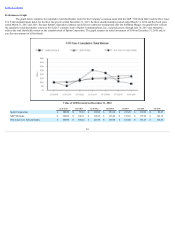Sprint - Nextel 2015 Annual Report Download - page 16
Download and view the complete annual report
Please find page 16 of the 2015 Sprint - Nextel annual report below. You can navigate through the pages in the report by either clicking on the pages listed below, or by using the keyword search tool below to find specific information within the annual report.
Table of Contents
If we fail to provide a competitive network, our ability to provide wireless services to our subscribers, to attract and retain subscribers, and to maintain
and grow our subscriber revenues could be adversely affected. For example, achieving optimal broadband network speeds, capacity, and coverage using 2.5 GHz
spectrum relies in significant part on operationalizing a complex mixture of BRS and EBS spectrum licenses and leases in the desired service areas. The EBS is
subject to licensing limitations and the technical limitations of the frequencies in the 2.5 GHz range. See "Item 1. Business-Legislative and Regulatory
Developments-Regulation and Wireless Operations-2.5 GHz License Conditions." If we are unable to operationalize this mixture of licenses and leases, our
targeted network modernization goals could be affected.
Using new and sophisticated technologies on a very large scale entails risks. For example, deployment of new technologies from time to time has
adversely affected, and in the future may adversely affect, the performance of existing services on our network and result in increased churn or failure to attract
wireless subscribers. Should implementation of our modernized network, which also includes expanding our network through densification using both macro sites
and small cells, be delayed or costs exceed expected amounts, our margins could be adversely affected and such effects could be material. Should the delivery of
services expected to be deployed on our modernized network be delayed due to technological constraints or changes, performance of third-party suppliers,
regulatory restrictions, including zoning and leasing restrictions, or permit issues, subscriber dissatisfaction, or other reasons, the cost of providing such services
could become higher than expected, ultimately increasing our cost to subscribers and resulting in decreases in net subscribers, which would adversely affect our
revenues, profitability, and cash flow from operations.
Our high debt levels and restrictive debt covenants could negatively impact our ability to access future financing at attractive rates or at all, which could limit
our operating flexibility and ability to repay our outstanding debt as it matures.
As of March 31, 2016 , our consolidated principal amount of indebtedness was $33.4 billion, and we had $3.0 billion of undrawn borrowing capacity
under the revolving bank credit facility. Our high debt levels and debt service requirements are significant in relation to our revenues and cash flow, which may
reduce our ability to respond to competition and economic trends in our industry or in the economy generally. Our high debt levels and debt service requirements
may also limit our financing options as a result of the restrictions placed on certain of our assets in our recent financing transactions. In addition, certain
agreements governing our indebtedness impose operating restrictions on us, subject to exceptions, including our ability to:
• pay dividends;
• create liens on our assets;
• receive dividend or other payments from certain of our subsidiaries;
• enter into transactions with affiliates; and
• engage in certain asset sale or business combination transactions.
Our revolving bank credit facility and other financing facilities also require that we maintain certain financial ratios, including a leverage ratio, which
could limit our ability to incur additional debt. Our failure to comply with our debt covenants would trigger defaults under those obligations, which could result in
the maturities of those debt obligations being accelerated and could in turn result in cross defaults with other debt obligations. If we are forced to refinance our debt
obligations prior to maturity on terms that are less favorable or if we were to experience difficulty in refinancing the debt prior to maturity, our results of operations
or financial condition could be materially harmed. In addition, our recent asset-based financings, which we expect to continue to rely on in the future as a source of
funds, could subject us to an increased risk of loss of assets secured under those facilities. Limitations on our ability to obtain suitable financing when needed, or at
all, or a failure to execute on our cost-reduction initiatives, could result in an inability to continue to expand our business, timely execute network modernization
plans, and meet competitive challenges.
Subscribers who purchase a device on an installment billing basis are no longer required to sign a fixed-term service contract, which could result in higher
churn, and higher bad debt expense.
Our service plans allow certain subscribers to purchase an eligible device under an installment contract payable over a period of up to 24 months.
Subscribers who take advantage of these plans are no longer required to sign a fixed-term service contract to obtain postpaid service; rather, their service is
provided on a month to month contract basis with no early termination fee. These service plans may not meet our subscribers’ or potential subscribers’ needs,
expectations, or demands. In addition, subscribers on these plans can discontinue their service at any time without penalty, other than the obligation of any residual
commitment they may have for unpaid service or for amounts due under the installment contract for the device. We could experience a higher churn rate than we
expect due to the ability of subscribers to more easily change service providers, which could adversely affect our results of operations. Our operational and
financial performance may be
14
























